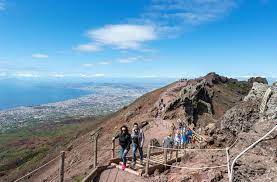Italy: How to visit volcanoes responsibly

Julia Buckley
Naples: Their fiery reputation might precede them, but Italy’s volcanoes aren’t necessarily difficult to visit. If you want to see the big three, Etna, Vesuvius and Stromboli (an island-volcano off Sicily’s north coast), the most important thing to know is that they’re all nature reserves and should be treated delicately.
“The mission of every park is to preserve its biodiversity,” says Agostino Casillo, president of the Parco Nazionale del Vesuvio. “And to do that, you have to link conservation with human activity.”
After all, at around 20,000 acres, there’s more to Vesuvius than just the cone. There are farms, vineyards, a medieval village (Casamale) and – Agostino’s favourite spot – the Cognoli di Ottaviano, a hike with panoramic views over the Valle dell’Inferno, Bay of Naples and Vesuvius itself. To savour it all, he recommends staying longer. “Tourism needs to focus on sustainability,” says Agostino. “Hit-and-run tourism is environmentally damaging and doesn’t financially benefit the community.”
Alberto Ciarallo agrees. As founder of Cognoscenti Travel, he arranges volcano hikes and helicopter tours of Etna and Stromboli, and suggests visitors stay overnight on the latter. “It’s theatrical and unique, as the entire island is a volcano,” he says. “But it’s quite small and can get crowded with hikers.”
On Etna, Alberto suggests not only tackling the volcano itself, but the surrounding countryside, taking a ride on the 19th-century Ferrovia Circumetnea, a local railway line that trundles around the foothills. Also recommended is a visit to the vineyards producing increasingly popular Etna wines, such as Cottanera. Here, travellers can tour the steeply terraced vines at the foot of the volcano before a wine-tasting session with superb homemade food.
If you’re going to the Gran Cono, or crater, of Vesuvius, it’s best approached from Ercolano (Herculaneum), says Mario Riccardi, a Campania guide with local co-operative Gaia. You can reach it by bus from the town’s Circumvesuviana railway station (take note that there are no toilet facilities once you set off to the crater). Buses will whizz you up the volcano to an elevation of around 3,200ft, from where a zigzagging trail takes you to the crater, about 1,000ft higher.
On Stromboli, it’s all about the eruptions, which happen roughly every 20 to 30 minutes. Tours leave a couple of hours before sunset, returning after dark, but to travel there responsibly you need a guide who knows the weather conditions, as well as those of the volcano, so they can warn about impending explosions or tsunamis. This expert assistance can help travellers put the island in context geologically and politically. “Tourists go home changed if they understand Stromboli,” says Adriano Di Pietro, a volcanologist guide with Magmatrek. Guides can also take you higher – visitors can hike to 950ft alone, but can reach 1,300ft with a guide.
So, when’s the best time to go? Mario Riccardi says any clear day is good for Vesuvius, though watch out for storms — the volcano is closed if there’s a chance of lightning. Alberto Ciarella advises late spring and late September for Stromboli and Etna as the former is busy in the summer, while there can be snow on Etna until May. “The spring offers carpets of wildflowers and the drama of melting snowcaps, with bright blue skies and glittering sea views,” he says. But make sure you don’t leave your visit to Stromboli until late in the year. “It’s almost impossible to reach the island in winter,” says Adriano Di Pietro.





